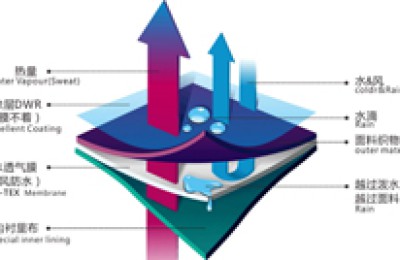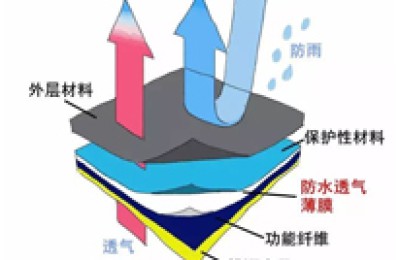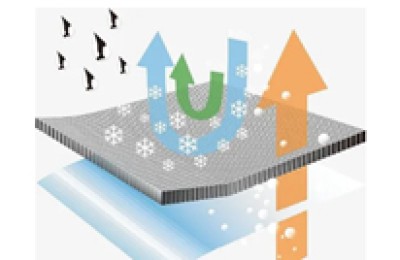Both the international and domestic markets, consumers have increasingly higher requirements for the dimensional stability of clothing. Especially in the international market, special requirements for anti-shrink, premium anti-shrink, and super anti-shrink are constantly put forward for fabrics. For printing and dyeing enterprises, shrinkage rate is a problem.
01 Mechanical pre-shrinking finishing
Using physical methods to reduce the shrinkage of fabrics after soaking in water to reduce shrinkage, also known as the finishing process Mechanical shrinking and finishing.
The fabric is subjected to tension in the warp direction during the dyeing and finishing process, and the buckling wave height in the warp direction is reduced, so elongation will occur.
When hydrophilic fiber fabrics are soaked in water, the fibers swell and the diameters of the warp and weft yarns increase, thereby increasing the buckling wave height of the warp yarns and shortening the length of the fabric, causing shrinkage.
The percentage of length reduction to the original length is called shrinkage. Mechanical preshrinking is to wet the fabric by spraying steam or spray first, and then apply mechanical extrusion in the warp direction to increase the buckling wave height, and then dry it through loose drying. The shrinkage rate of pre-shrunk cotton can be reduced to less than 1%, and due to the mutual extrusion and rubbing between fibers and yarns, the softness of the fabric’s hand will also be improved. Wool fabrics can be relaxed and pre-shrunk. After the fabric is padded with warm water or sprayed with steam, it is slowly dried in a relaxed state to cause the fabric to shrink in both the warp and weft directions.
02 Equipment Classification
1. Rubber blanket pre-shrinking machine
The commonly used one is the three-roller type, which is mainly composed of a certain thickness and elastic ring-shaped seamless rubber blanket, a cloth feeding roller and a pressure-bearing roller with a smooth surface and which can be heated (Figure 1).
The rubber blanket maintains an appropriate tension and circulates. After passing between the cloth feeding roller and the pressure roller, the two rollers have a rolling point P ( Figure 2), the fabric enters between the pressure roller and the rubber blanket from the rolling point P, and runs accordingly. When the rubber blanket is wrapped on the feeding roller, its outer arc is extended (A in Figure 2). When the rubber blanket passes through the nip point and is wrapped on the pressure roller, the originally extended outer arc changes to an inner arc and shrinks (Figure 2 A’); In addition, when the rubber blanket enters the rolling point P, it is thinned and stretched. After exiting the rolling point, it shrinks on its own in the PS section and gradually returns to its original thickness, so that the fabric is tightly pressed between the rubber blanket and the pressure roller. When pressed, the rubber blanket shrinks together to achieve a pre-shrinking effect. The three-roller shrinking machine is equipped with a moistening and loosening drying device, and can be used for cotton fabrics and blended fabrics of cotton and chemical fibers.
2. Two-roller block pre-shrinking machine
Mainly It consists of a cloth feeding roller, a retard roller and a platen knife (Figure 3). The cloth feeding roller has a smooth surface and a fast running speed. The rubber surface hardness of the retard roller is lower and the running speed is slightly slower than that of the cloth feed roller. The front end of the pressing plate is installed near the point where the two rollers enter.
During the pre-shrinking process, the fabric is fed in at a faster speed by the feeding roller. When entering the nip point, due to the slow speed of the retard roller and the resistance at the front end of the pressing plate, the fabric is squeezed and shrinks. . By adjusting the speed difference between the cloth feeding roller and the retard roller, or controlling the distance between the front end of the pressing plate and the nip point, you can control the shrinkage effect of the fabric. The two-roller shrinking machine is combined with moisture supply, drying and other devices and is used for knitted fabrics. When the fabric is tentered using a needle plate tenter equipped with an overfeed device, the warp preshrinking effect can also be obtained due to the overfeeding of the fabric due to the relaxation in the warp direction and the application of tension in the weft direction, which is especially suitable for light and thin fabrics.
03 The function and method of pre-shrinking finishing
The purpose of fabric pre-shrinking finishing is to make The fabric undergoes a certain amount of shrinkage in the warp and weft directions to reduce the shrinkage of the final product and meet the quality requirements of garment processing. Mechanical shrinking uses a compressible rubber blanket to carry the fabric for shrinking. When the rubber blanket is curled under force, the outer arc elongates and the inner arc contracts. If it is bent in the opposite direction, the originally elongated side becomes contracted, and the contracted side elongates. During the pre-shrinking process, the fabric with a certain humidity runs close to the rubber blanket, passing through the compression zone, from the outer arc of the rubber blanket to the inner arc, that is, from the stretching part to the shrinking part, because the fabric is clamped by the rubber blanket and the pressure roller. It is held without being allowed to slide. As the rubber blanket recovers and shrinks, it is compressed, resulting in a certain shrinkage.
Usually, the fabric is properly moistened (10% to 15%) and heated before the machine, so that the fiber becomes softer and has greater plasticity. It is also done before being wetted (singeing). After finishing), it is first subjected to light slurry penetration or foam sizing and drying drum drying to strengthen pre-shrink control and improve pre-shrink effect. When the fabric is pre-shrunk by the rubber blanket, it is pre-dried to remove part of the moisture. After leaving the machine, it is dried and ironed in a tension-free blanket dryer to eliminate wrinkles caused by excessive shrinkage during compression to obtain a plump texture. Hand feel and soft shine.
04 Key points of pre-shrinking finishing process
Three stability must be maintained during pre-shrinking treatment, that is, the speed of the pre-shrinking machine should be kept stable and enter the rubber blanket unit
When the fiber is spinning, or when the yarn is weaving, dyeing and finishing, the yarn fibers in the fabric are elongated or deformed by external forces. At the same time, the yarn fibers and the fabric structure generate internal stress, which is in a static dry relaxation state. , or in a static wet relaxation state, or in a dynamic wet relaxation state, or a full relaxation state, the internal stress is released to varying degrees, causing the yarn, fiber and fabric to return to their original state.
Different fibers and their fabrics have different shrinkage degrees, which mainly depend on the characteristics of the fibers – hydrophilic fibers shrink to a greater degree, such as cotton, linen, and viscose. Fibers such as glue; while hydrophobic fibers shrink less, such as synthetic fibers.
When the fiber is in a wet state, it will swell due to the action of the soaking liquid, making the fiber diameter larger. For example, on a fabric, it forces the fiber curvature radius of the interweaving point of the fabric to increase. , causing the length of the fabric to shorten. For example, cotton fiber expands under the action of water, and its cross-sectional area increases by 40 to 50% and its length increases by 1 to 2%, while synthetic fibers shrink by heat, such as boiling water, generally about 5%.
When textile fibers are heated, the shape and size of the fibers change and shrink, and they cannot return to their original state after cooling, which is called thermal shrinkage of the fibers. The percentage of length before heat shrinkage and after heat shrinkage is called heat shrinkage rate. It is generally measured by boiling water shrinkage. In boiling water at 100°C, the percentage of fiber length shrinkage is expressed. It can also be expressed by hot air method, in hot air exceeding 100°C. To measure the shrinkage percentage, you can also use the steam method to measure the shrinkage percentage in steam exceeding 100°C. Fibers behave differently due to their internal structure and heating temperature, time and other conditions. For example, the boiling water shrinkage rate of polyester staple fiber processing is 1%, the boiling water shrinkage rate of vinylon is 5%, and the hot air shrinkage rate of chlorine fiber is 50%. Fibers are closely related in textile processing and the dimensional stability of fabrics, which provides some basis for the design of post-processes.
The shrinkage rate of general fabrics is cotton 4%–10%; chemical fiber 4%–8%; cotton-polyester 3.5%–55%; natural white cloth is 3% ; Wool blue cloth is 3-4%; poplin is 3-4.5%; floral cloth is 3-3.5%; twill cloth is 4%; denim is 10%; artificial cotton is 10%.
08 Factors affecting fabric shrinkage
1. Raw materials
Different raw materials of fabrics have different shrinkage rates . Generally speaking, fibers with high hygroscopicity will expand when soaked in water, increase in diameter, shorten in length, and have a large shrinkage rate. For example, the water absorption rate of some viscose fibers is as high as 13%, while synthetic fiber fabrics have poor hygroscopicity and their shrinkage rate is small.
2. Density
The fabric has different densities and different shrinkage rates. If the longitudinal and latitudinal densities are similar, the longitudinal and latitudinal shrinkage rates are also similar. Fabrics with a higher warp density will shrink more in the warp direction; conversely, fabrics with a higher weft density than warp density will shrink more in the weft direction.
3. Thickness of yarn count
Different yarn count thicknesses of fabrics lead to different shrinkage rates. Fabrics with a thicker yarn count will have a greater shrinkage rate, while fabrics with a finer yarn count will have a smaller shrinkage rate.
4. Production process
Different fabric production processes lead to different shrinkage rates. Generally speaking, during the weaving, dyeing and finishing process of fabrics, the fibers have to be stretched many times, and the processing time is long. The shrinkage of fabrics with greater tension will be greater, and vice versa.
5. Fiber composition
Natural plant fibers (such as cotton, linen) and plant regenerated fibers (such as viscose) and Compared with synthetic fibers (such as polyester and acrylic), they are easy to absorb moisture and expand, so the shrinkage rate is larger. Wool is easy to felt due to the scale structure on the fiber surface, which affects its dimensional stability.
6. Fabric structure
Generally, the dimensional stability of woven fabrics is better than that of knitted fabrics; high-density fabrics The dimensional stability is better than that of low density. Among woven fabrics, the shrinkage rate of plain weave fabrics is generally smaller than that of flannel fabrics; while among knitted fabrics, the shrinkage rate of plain knitted fabrics is smaller than that of ribbed fabrics.
7. Production and processing process
Due to the process of dyeing, printing and finishing, fabrics will inevitably be affected by machine damage. Stretch, so tension exists on the fabric. However, fabrics easily release tension when exposed to water, so we may notice shrinkage in the fabric after washing. In actual processes, we generally use pre-shrinking to solve this problem.
8. Washing care process
Washing care includes washing, drying, and ironing. Each of these three steps will affect Shrinkage of fabric. For example, the dimensional stability of hand-washed samples is better than that of machine-washed samples, and the washing temperature will also affect its dimensional stability. Generally speaking, the higher the temperature, the worse the stability. The drying method of the sample also has a relatively large impact on the shrinkage of the fabric. </p







